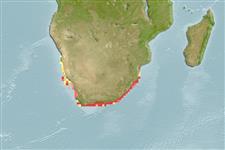>
Siluriformes (Catfishes) >
Ariidae (Sea catfishes) > Galeichthyinae
Etymology: Galeichthys: Greek, galeos = a shark + Greek, ichthys = fish (Ref. 45335).
More on author: Valenciennes.
Environment: milieu / climate zone / depth range / distribution range
生態学
海; 汽水性の 底生の; 両側回遊性 (Ref. 51243); 深さの範囲 ? - 120 m (Ref. 27121). Subtropical; 23°S - 35°S, 14°E - 33°E
Southeast Atlantic: Walvis Bay, Namibia to the vicinity of East london, South Africa (Ref. 85159). Records from Guinea-Bissau as Tachysurus feliceps and from Guinea as Arius feliceps are erroneous.
Length at first maturity / サイズ / 重さ / 年齢
Maturity: Lm 26.3, range 25 - 27.5 cm
Max length : 55.0 cm TL オス/雌雄の選別がない; (Ref. 3976); common length : 35.0 cm TL オス/雌雄の選別がない; (Ref. 3546)
脊つい: 51 - 52. This species is distinguished by the following characters: head longer than, or nearly as long as, broad; tooth patches are posterior to premaxillary band touch at midline; relatively long and thin maxillary barbel, extending at least to pectoral fin spine origin (longer in females); dorsal fin spine length more than 70% of its height; pectoral-fin spine at vertical extends at most to hind edge of dorsal fin base; deeply forked caudal fin with moderately slender, with pointed lobes, upper lobe longer; caudal peduncle approximately twice as long as deep; 11-14 gill-rakers on anterior face of first arch; upper two-thirds of body darkened, some lateral speckling and belly stark white; median anterior cranial fontanelle (of exposed skull) elongate and bullet-shaped; smooth and shallow median cranial depression, deepest posteriorly at frontal/supraoccipital suture. 10-12 pectoral fin rays; 51-52 (17 precaudal, 34-35 caudal) total vertebrae. Dimorphism of posterior (humeral) process of cleithrum obvious externally, in females, fan-shaped, in males triangular (Ref. 85159).
Generally found in large shoals on muddy bottoms in turbid waters, usually on the coastline and estuaries. Also found in rivers (Ref. 3976). Feed on crayfish, small fish, and crabs (Ref. 27121). Considered a nuisance of shore and ski-boat anglers in southern Africa as little else is caught (Ref. 12484). Spines are poisonous and wounds should be treated immediately. Marketed smoked (Ref. 36731).
Life cycle and mating behavior
成熟 | 繁殖 | 放精 | 卵 | 生産力 | 幼生
A paternal mouthbrooder.
Kulongowski, C., 2010. Revision of the ariid catfish genus Galeichthys Valenciennes (subfamily Galeichthyinae), with description of a new species from South Africa and designation of a neotype for G. ater Castelnau. Smithiania Bull. (12):9-23. (Ref. 85159)
Human uses
水産業: 商業; 水族館・水槽: 公共の水族館
より多くの情報
協力者画像Stamps, Coins Misc.音シガテラ(食中毒の名前)速度泳ぐ 型式カマOtoliths脳視覚
用具
特記事項
XMLをダウンロードして下さい
インターネットの情報源
Estimates based on models
Preferred temperature (Ref.
123201): 15.5 - 27.7, mean 24.7 °C (based on 222 cells).
Phylogenetic diversity index (Ref.
82804): PD
50 = 0.5625 [Uniqueness, from 0.5 = low to 2.0 = high].
Bayesian length-weight: a=0.00871 (0.00476 - 0.01595), b=2.98 (2.81 - 3.15), in cm total length, based on LWR estimates for this species & (Sub)family-body (Ref.
93245).
栄養段階 (Ref.
69278): 3.8 ±0.2 se; based on diet studies.
回復力 (Ref.
120179): 手段, 1.4年~4.4年の倍増期間の最小個体群 (Assuming tm=2-3).
Fishing Vulnerability (Ref.
59153): Moderate vulnerability (42 of 100).
Climate Vulnerability (Ref.
125649): Moderate to high vulnerability (52 of 100).
Nutrients (Ref.
124155): Calcium = 58.8 [31.1, 163.4] mg/100g; Iron = 0.982 [0.617, 1.768] mg/100g; Protein = 19.1 [16.4, 21.4] %; Omega3 = 0.447 [0.242, 0.840] g/100g; Selenium = 28.8 [15.4, 56.8] μg/100g; VitaminA = 12.4 [4.9, 32.0] μg/100g; Zinc = 0.798 [0.538, 1.212] mg/100g (wet weight); based on
nutrient studies.
